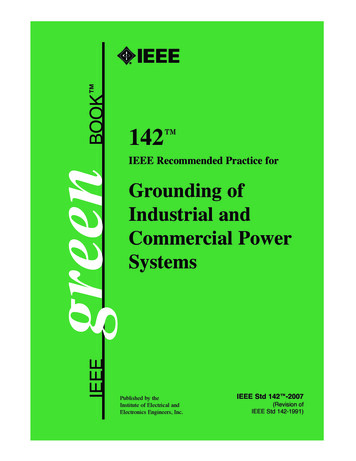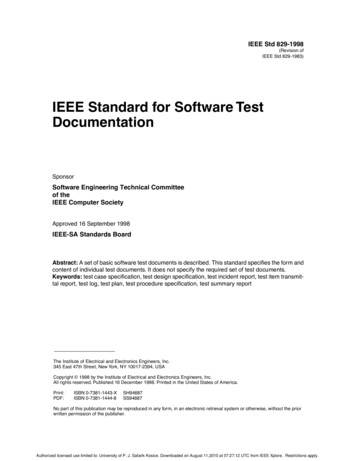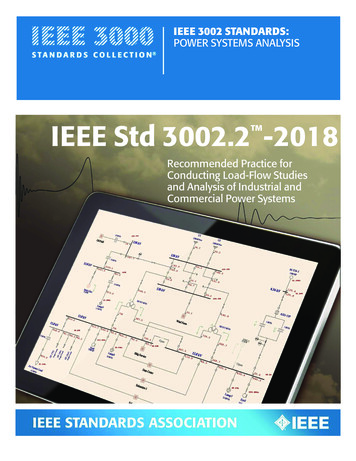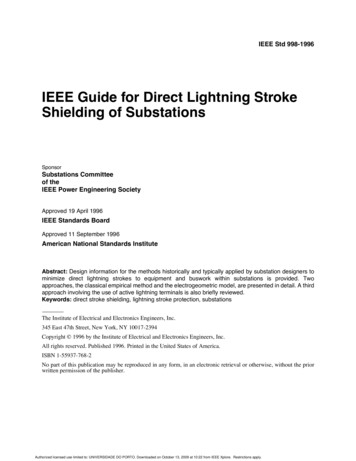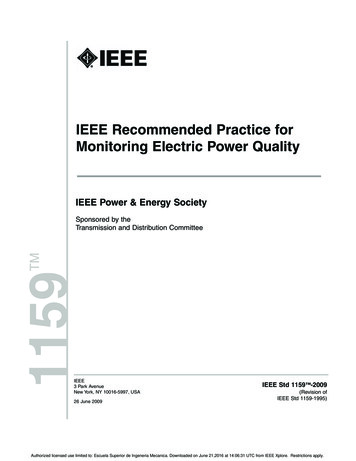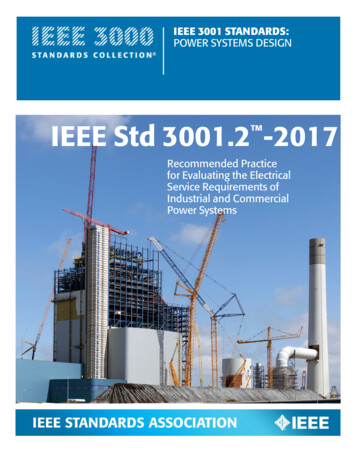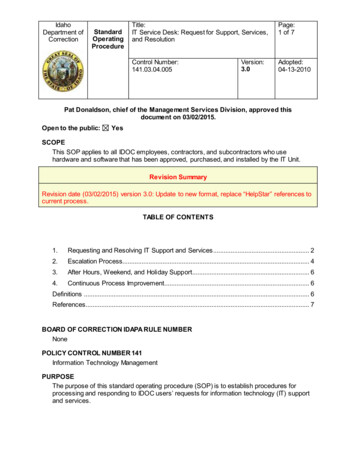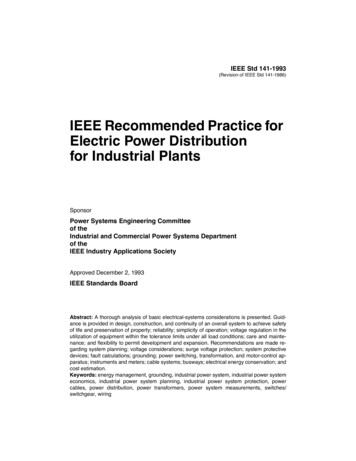
Transcription
IEEE Std 141-1993(Revision of IEEE Std 141-1986)IEEE Recommended Practice forElectric Power Distributionfor Industrial PlantsSponsorPower Systems Engineering Committeeof theIndustrial and Commercial Power Systems Departmentof theIEEE Industry Applications SocietyApproved December 2, 1993IEEE Standards BoardAbstract: A thorough analysis of basic electrical-systems considerations is presented. Guidance is provided in design, construction, and continuity of an overall system to achieve safetyof life and preservation of property; reliability; simplicity of operation; voltage regulation in theutilization of equipment within the tolerance limits under all load conditions; care and maintenance; and flexibility to permit development and expansion. Recommendations are made regarding system planning; voltage considerations; surge voltage protection; system protectivedevices; fault calculations; grounding; power switching, transformation, and motor-control apparatus; instruments and meters; cable systems; busways; electrical energy conservation; andcost estimation.Keywords: energy management, grounding, industrial power system, industrial power systemeconomics, industrial power system planning, industrial power system protection, powercables, power distribution, power transformers, power system measurements, switches/switchgear, wiring
Grateful acknowledgment is made to the following organizations for having granted permission to reprint illustrations in this document as listed below:Table 3-1 from ANSI C84.1-1989, American National Standard for Electric Power Systems and EquipmentÑVoltage Ratings (60 Hz), copyright 1989 by the American National Standards Institute.Figure 3-7 from NEMA Standards Publication MG 1-1993, copyright held by the National ElectricalManufacturers Association.Figure 5-4 from Basler Electric, Highland, IL.Figure 5-5 from General Electric Company, Malvern, PA.Figure 6-6 from the Industrial Power Systems Data Book, General Electric Company, Schenectady, NY.Figure 6-11 from D. L. Beeman, Ed., Industrial Power Systems Handbook, McGraw-Hill, New York, NY,1955.The Institute of Electrical and Electronics Engineers, Inc.345 East 47th Street, New York, NY 10017-2394, USACopyright 1994 by the Institute of Electrical and Electronics Engineers, Inc.All rights reserved. Published 1994. Printed in the United States of America.ISBN 1-55937-333-4No part of this publication may be reproduced in any form, in an electronic retrieval system or otherwise,without the prior written permission of the publisher.
IEEE Standards documents are developed within the Technical Committees of the IEEESocieties and the Standards Coordinating Committees of the IEEE Standards Board. Members of the committees serve voluntarily and without compensation. They are not necessarilymembers of the Institute. The standards developed within IEEE represent a consensus of thebroad expertise on the subject within the Institute as well as those activities outside of IEEEthat have expressed an interest in participating in the development of the standard.Use of an IEEE Standard is wholly voluntary. The existence of an IEEE Standard does notimply that there are no other ways to produce, test, measure, purchase, market, or provideother goods and services related to the scope of the IEEE Standard. Furthermore, the viewpoint expressed at the time a standard is approved and issued is subject to change broughtabout through developments in the state of the art and comments received from users of thestandard. Every IEEE Standard is subjected to review at least every Þve years for revision orreafÞrmation. When a document is more than Þve years old and has not been reafÞrmed, it isreasonable to conclude that its contents, although still of some value, do not wholly reßect thepresent state of the art. Users are cautioned to check to determine that they have the latest edition of any IEEE Standard.Comments for revision of IEEE Standards are welcome from any interested party, regardlessof membership afÞliation with IEEE. Suggestions for changes in documents should be in theform of a proposed change of text, together with appropriate supporting comments.Interpretations: Occasionally questions may arise regarding the meaning of portions of standards as they relate to speciÞc applications. When the need for interpretations is brought tothe attention of IEEE, the Institute will initiate action to prepare appropriate responses. SinceIEEE Standards represent a consensus of all concerned interests, it is important to ensure thatany interpretation has also received the concurrence of a balance of interests. For this reasonIEEE and the members of its technical committees are not able to provide an instant responseto interpretation requests except in those cases where the matter has previously received formal consideration.Comments on standards and requests for interpretations should be addressed to:Secretary, IEEE Standards Board445 Hoes LaneP.O. Box 1331Piscataway, NJ 08855-1331USAIEEE Standards documents may involve the use of patented technology. Theirapproval by the Institute of Electrical and Electronics Engineers does not mean thatusing such technology for the purpose of conforming to such standards is authorizedby the patent owner. It is the obligation of the user of such technology to obtain allnecessary permissions.
This page intentionally left blank
Introduction(This introduction is not part of IEEE Std 141-1993, IEEE Recommended Practice for Electric PowerDistribution for Industrial Plants.)Development of the IEEE Red Book has been an evolving process. With the publication ofIEEE Std 141-1993, the Red Book has been in print for about Þfty years. Work began on theseventh edition in 1987 with the participation of more than seventy electrical engineers fromindustrial plants, consulting Þrms, equipment manufacturers, and academe. It was sponsoredand the Þnal version approved by the Power Systems Design Subcommittee of the PowerSystems Engineering Committee, Industrial and Commercial Power Systems Department,IEEE Industry Applications Society. The seventh edition was approved by the IEEE Standards Board in 1993 as an IEEE Recommended Practice. It provides pertinent informationand recommended practices for the design, construction, operation, and maintenance of electric power systems in industrial plants.The Þrst publication was developed in 1945 by the Committee on Industrial Power Applications of the American Institute of Electrical Engineers (AIEE). It was entitled Electric PowerDistribution for Industrial Plants and sold for 1.00 a copy. It became known by the nickname ÒRed BookÓ because of its red cover, and a precedent was established for the presentIEEE Color Book series, which now encompasses ten books.The second edition was published in 1956. The committee responsible for its preparation hadbecome a subcommittee of the Industrial Power Systems Committee of the AIEE. This edition was identiÞed as AIEE Number 952.By 1964, the AIEE had become the Institute of Electrical and Electronics Engineers and thethird edition was identiÞed as IEEE No. 141. The fourth edition was produced in 1969,approved as an IEEE Recommended Practice, and identiÞed as IEEE Std 141-1969. The Þfthedition, published in 1976, was IEEE Std 141-1976, and the sixth edition, published in 1986,became an American National Standard as well as an IEEE Recommended Practice, and wasidentiÞed as ANSI/IEEE Std 141-1986.The authors of this 1993 edition wish to acknowledge their indebtedness to the several hundred engineers whose expertise and work culminated in the six previous editions. The presentstature of the Red Book would not have been achieved without their efforts.v
The Red Book Working Group for the 1993 edition had the following membership:William J. Moylan, ChairR. Gerald Irvine, Technical SupportLynn Saunders, SecretaryLucas G. Ananian, Advisory CounselChapter 1: OverviewÑDan Goldberg, Chair; Arthur Freund; R. Gerald Irvine;C. Grant Keough; Philip Nobile; Don ZipseChapter 2: Systems planningÑLynn Saunders, Chair; Robert Beaker; Carl Becker;B. L. Christen; Tom Diliberti; William Moylan; Don Pomering; Ronald Smith;Ray Stratford; S. I. Venugopalan; Don ZipseChapter 3: Voltage considerationsÑLarry Conrad, Co-Chair; Gary Smullin, Co-Chair;Carl Becker; Don Brereton; R. Gerald Irvine; S. I. VenugopalanChapter 4: Fault calculationsÑWalter C. Huening, Chair; Carl Becker; Richard Evans;Shan GrifÞth; Mark Leyton; Conrad St. PierreChapter 5: Application and coordination of protective devicesÑDavid Baker, Chair;Jerry Baskin; Steve Goble; R. Gerald Irvine; William Moylan; Randall SchlakeChapter 6: Surge voltage protectionÑWei-Jen Lee, Chair; David Baker; Carl Becker;Gilbert Gaibrois; Shan GrifÞth; William Moylan; George WalshChapter 7: GroundingÑDonald W. Zipse, Chair; Robert Beaker; Kenneth Nicholson;Jerry Brown; Daleep Mohla; Charles Dennis; Milton Robinson; S. I. VenugopalanChapter 8: Power factor and related considerationsÑWilliam Moylan, Chair;Carl Becker; James Harvey; Warren Lewis; Ray Stratford; George WalshChapter 9: Harmonics in power systemsÑRay Stratford, Chair; Larry Conrad;Dennis Darling; William MoylanChapter 10: Power switching, transformation, and motor control apparatusÑSonny Sengupta, Chair; Jerry Frank; Douglas Kanitz; R. Gerald Irvine;Harold Miles; William MoylanChapter 11: Instruments and metersÑLarry Conrad, Chair; Valdis Basch; Harry Beckman;Dennis Darling; James Harvey; Yoshi HeldChapter 12: Cable systemsÑJames Daly, Chair; Robert Beaker; Gordon Bracey;Larry Kelly; Lynn SaundersChapter 13: BuswaysÑJohn Schuster, Chair; Louis Capitina; Steven Flee; Robert Gustin;Robert Ingham; James Lewis; William Moylan; Lynn SaundersChapter 14: Electrical conservation through energy managementÑCarl Becker, Chair;Kao Chen; Joseph Eto; Dan Goldberg; R. Gerald Irvine; C. Grant KeoughChapter 15: Industrial substations: Plant-utility interface considerationsÑTom Diliberti, Co-Chair; Ron Smith, Co-Chair; Jerry Baskin; Carl Becker;C. W. Bierl; Larry Conrad; Joseph Dudor; Paul Gulik; Robert Hoerauf;Daleep Mohla; William Moylan; Lynn Saunders; Michael Stark; Don ZipseChapter 16: Cost estimating of industrial power systemsÑSonny Sengupta, Co-Chair;Charles Dennis, Co-Chair; Robert Giese, Erling Hesla; Srimohan Jha;William Moylan; Malcolm Woodman; Don Zipsevi
At the time this document was balloted, the Power Systems Design Subcommittee had thefollowing membership:Stephen J. Schaffer, ChairL. G. AnanianR. J. BeakerJ. H. BeallC. E. BeckerR. W. BeckerG. R. J. BraceyD. S. BreretonR. CastenschioldL. E. ConradJ. M. DalyJ. EtoR. A. EvansL. F. FlaggJ. M. FrankE. O. GalyonS. GobleD. L. GoldbergA. P. HaggertyJ. R. HarveyR. G. HoeraufL. F. HogrebeR. W. InghamR. G. IrvineD. R. KanitzS. C. KapoorC. G. KeoughT. S. KeyC. A. LaPlatneyS. A. LarsonM. Z. LowensteinH. C. MilesD. C. MohlaW. J. MoylanJ. R. PfafßinC. R. PopeM. D. RobinsonV. SaporitaL. F. SaundersL. H. Smith, Jr.G. T. SmullinT. E. SparlingS. I. VenugopalanW. N. VernonP. A. ZinkD. W. ZipseOthers who contributed to the development of this document are as follows:Bruce Bailey, Richard Doughty, William Kelly, Richard McFadden, Robert SimpsonSpecial recognition is given to Jeannette Pierce and Barbara Abitz for their contributions tothe Red Book through coordination of balloting, document preparation, and liaison withchapter chairs.The following persons were on the balloting committee:Lucas AnanianRobert J. BeakerJames H. BeallCarl E. BeckerRene CastenschioldJames M. DalyRichard EvansJerry M. FrankEdgar O. GalyonSteven GobleDaniel L. GoldbergPatrick A. HaggertyJames R. HarveyRobert G. HoeraufRobert W. InghamR. Gerald IrvineEd KalksteinDouglas R. KanitzS. C. KapoorC. Grant KeoughThomas S. KeySteven A. LarsonWei-Jen LeeMichael LowensteinDaleep C. MohlaWilliam J. MoylanMilton D. RobinsonVincent SaporitaLynn F. SaundersStephen J. SchafferLester H. SmithThomas E. SparlingS. I. VenugopalanPhilip A. ZinckDonald W. Zipsevii
When the IEEE Standards Board approved this standard on December 2, 1993, it had thefollowing membership:Wallace S. Read, ChairGilles A. BarilJosŽ A. Berrios de la PazClyde R. CampDonald C. FleckensteinJay Forster*David F. FranklinRamiro GarciaDonald N. HeirmanDonald C. Loughry, Vice ChairAndrew G. Salem, SecretaryJim IsaakBen C. JohnsonWalter J. KarplusLorraine C. KevraE. G. ÒAlÓ KienerIvor N. KnightJoseph L. KoepÞnger*D. N. ÒJimÓ LogothetisDon T. Michael*Marco W. MigliaroL. John RankineArthur K. ReillyRonald H. ReimerGary S. RobinsonLeonard L. TrippDonald W. Zipse*Member EmeritusAlso included are the following nonvoting IEEE Standards Board liaisons:Satish K. AggarwalJames BeallRichard B. EngelmanDavid E. SoffrinStanley I. WarshawPaula M. KeltyIEEE Standards Project Editorviii
AcknowledgmentsWe gratefully acknowledge the contributions of time, talent, and expertise the following organizations have made toward the development of this Recommended Practice:AT&TBICC Cables CorporationBrown & Root, Inc. and Associated CompaniesBrown & Root, BraunCarlsons Consulting Engineers, Inc.Clarence P. Tsung & AssociatesCleveland Electric Illuminating CompanyCooper Industries, Bussmann DivisionDetroit EdisonDuPont CompanyElectrical Systems Analysis (ESA)FMC CorporationGeneral Electric CompanyGiese & AssociatesHoechst Celanese CorporationICF Kaiser Engineers, Inc.Industra Inc., Engineers & ConsultantsInternational Transformer CorporationJohn Brown E & CMiddle Tennessee State University (MTSU)Moylan Engineering Associates, Inc.Oak Ridge National Laboratory, MMESPower Technology Consultants, P.A.Power Technologies, Inc.Square D CompanyUnion CarbideThe University of Texas at ArlingtonWestinghouse Electric CorporationWunderlich-Malec Engineering, Inc.ix
This page intentionally left blank
ContentsCLAUSEPAGEChapter 1Overview. 151.161.171.181.191.201.21Scope and general information . 1Industrial plants. 1Industry Applications Society (IAS). 5Professional registration. 6Professional liability . 7Codes and standards. 7Handbooks . 10Periodicals. 11ManufacturersÕ Data . 12Safety . 12Maintenance. 15Design considerations . 15Estimating . 19Contracts . 20Access and loading . 21Contractor performance . 21Environmental considerations. 22Technical files. 22Electronic systems . 22Programmable logic controller . 24Bibliography . 24Chapter 2System planning. 272.12.22.32.42.52.62.7Introduction. 27Definitions. 27Basic design considerations . 27Planning guide for the supply and distribution system. 31Power system modernization and evaluation studies/programs . 56References. 58Bibliography . 59Chapter 3Voltage considerations. 613.13.23.33.4General. 61Voltage control in electric power systems . 66Voltage selection. 78Voltage ratings for low-voltage utilization equipment . 81xi
IEEEStd NTSPAGEEffect of voltage variations on low-voltage and medium-voltageutilization equipment . 82Voltage drop considerations in locating the low-voltage secondarydistribution system power source. 86Improvement of voltage conditions . 87Phase-voltage unbalance in three-phase systems. 89Voltage sags and flicker. 91Harmonics . 95Calculation of voltage drops . 96References. 107Bibliography . 108Chapter 4Short-circuit current calculations. 1094.14.24.34.44.54.6Introduction. 109Sources of fault current. 109Fundamentals of short-circuit current calculations. 112Restraints of simplified calculations. 115Detailed procedure . 124Example of short-circuit current calculation for a power system withseveral voltage levels . 1384.7 Example of short-circuit current calculation for a low-voltage system(under 1000 V). 1584.8 Calculation of short-circuit currents for dc systems . 1704.9 References. 1704.10 Bibliography . 171Annex 4ATypical impedance data for short-circuit studies. 173Chapter 5Application and coordination of protective devices . 1855.15.25.35.45.55.65.75.85.95.10xiiPurpose. 185Analysis of system behavior and protection needs . 187Protective devices and their applications. 192Performance limitations . 222Principles of protective relay application [38], [40], [50] . 223Protection requirements . 238Use and interpretation of time-current coordination curves . 250Specific examplesÑapplying the fundamentals. 260Acceptance testing (commissioning), maintenance, and field testing . 281Bibliography . 304
CONTENTSCLAUSEIEEEStd 141-1993PAGEChapter 6Surge voltage protection . 3116.16.26.36.46.56.66.76.86.9Nature of the problem . 311Traveling-wave behavior . 315Insulation voltage withstand characteristics . 322Arrester characteristics and ratings. 330Arrester selection . 336Selection of arrester class. 338Application concepts. 340References. 355Bibliography . 357Chapter 7Grounding . 3637.17.27.37.47.57.67.77.8Introduction. 363System grounding . 363Equipment grounding. 370Static and lightning protection grounding. 375Connection to earth . 379Ground resistance measurement . 383References. 389Bibliography . 389Chapter 8Power factor and related considerations . 8.158.168.17General scope. 393Current and power flow fundamentals. 394Benefits of power-factor improvement. 397Typical plant power factor . 402Instruments and measurements for power-factor studies. 404Techniques to improve the power factor . 405Calculation methods for improving power factor. 410Location of reactive power supply. 411Capacitors with induction motors . 412Capacitor standards and operating characteristics . 422Controls for switched capacitors. 425Transients and capacitor switching. 427Protection of capacitors and capacitor banks. 435Resonance and harmonics. 437Inspection and field testing of power capacitors. 438References. 440Bibliography . 442xiii
IEEEStd 141-1993CLAUSECONTENTSPAGEChapter 9Harmonics in power systems . tion. 443Importance of understanding effects of harmonics. 443History of harmonic problems and solutions . 444Definition and sources of harmonic currents and voltages. 445Characteristics of harmonics. 447Static power converter theory . 449System response characteristics. 455Effects of harmonics . 458Harmonic analysis. 466Mitigation techniques. 467Industry standards . 471Bibliography . 473Chapter 10Power switching, transformation, and motor control apparatus . 47510.110.210.310.410.510.610.710.8Introduction. 475Switching apparatus for power circuits. 478Switchgear. 492Transformers . 503Unit substations. 519Motor control equipment . 521Adjustable speed drives . 529Bibliography . 532Chapter 11Instruments and meters . uction. 537Basic objectives . 540Switchboard and panel instruments . 540Portable instruments. 542Recording instruments . 543Miscellaneous instruments. 544Meters . 545Auxiliary devices .
The existence of an IEEE Standard does not imply that there are no other ways to produce, test, measure, purchase, market, or provide other goods and services related to the scope of the IEEE Standard. Furthermore, the view-point expressed at the time a standard


